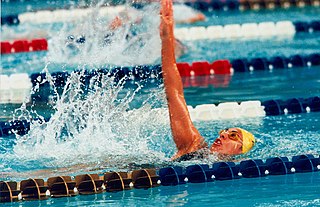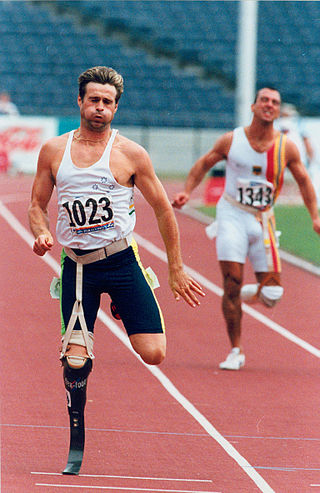Related Research Articles

The Summer Paralympics, also known as the Games of the Paralympiad, are an international multi-sport event where athletes with physical disabilities compete. This includes athletes with mobility disabilities, amputations, blindness, and cerebral palsy. The Paralympic Games are held every four years, organized by the International Paralympic Committee. Medals are awarded in every event, with gold medals for first place, silver for second and bronze for third, a tradition that the Olympic Games started in 1904.

S8, SB7, SM8 are disability swimming classifications used for categorizing swimmers based on their level of disability. This class includes a number of different disabilities including people with amputations and cerebral palsy. The classification is governed by the International Paralympic Committee, and competes at the Paralympic Games.

T44 is a disability sport classification for disability athletics, applying to "Single below knee amputation or an athlete who can walk with moderately reduced function in one or both legs." It includes ISOD A4 and A9 classes.

T46 and F46 are disability sport classification for disability athletics. People in this class have a single below or above the elbow amputation. The amputee sports equivalent class is ISOD the A6 and A8 classes. People in this class can have injuries as a result of over use of their remaining upper limb. The classification process to be included in this class has four parts: a medical exam, observation during training, observation during competition and then being classified into this class.
Disability sports classification is a system that allows for fair competition between people with different types of disabilities.
ARST is a Paralympic archery classification. It is a standing class. This class includes Les Autres sportspeople. People from this class compete in the sport at the Paralympic Games. Some people in this class can use stools or have an assistant nock their arrows. Classification is handled by FITA – International Archery Federation.
Para-athletics classification is a system to determine which athletes with disabilities may compete against each other in para-athletics events. Classification is intended to group together athletes with similar levels of physical ability to allow fair competition. Classification was created and is managed by the International Paralympic Committee (IPC), which is regularly published via its IPC Athletics Classification Handbook. People with physical, vision and intellectual disabilities are eligible to compete in this sport at the Summer Paralympics. The classification for this sport was created during the 1940s and for much of its early history was a medical condition based classification system. The classification system has subsequently become a functional mobility based one, and is moving towards an evidence-based classification system.
Para-equestrian classification is a system for para-equestrian sport is a graded system based on the degree of physical or visual disability and handled at the international level by the FEI. The sport has eligible classifications for people with physical and vision disabilities. Groups of eligible riders include The sport is open to competitors with impaired muscle power, athetosis, impaired passive range of movement, hypertonia, limb deficiency, ataxia, leg length difference, short stature, and vision impairment. They are grouped into five different classes to allow fair competition. These classes are Grade I, Grade II, Grade III, Grade IV, and Grade V(Grade Names Changed as of Jan 2017). The para-equestrian classification does not consider the gender of the rider, as equestrines compete in mixed gender competitions.
Cerebral palsy sport classification is a classification system used by sports that include people with cerebral palsy (CP) with different degrees of severity to compete fairly against each other and against others with different types of disabilities. In general, Cerebral Palsy-International Sports and Recreation Association (CP-ISRA) serves as the body in charge of classification for cerebral palsy sport, though some sports have their own classification systems which apply to CP sportspeople.
Amputee sports classification is a disability specific sport classification used for disability sports to facilitate fair competition among people with different types of amputations. This classification was set up by International Sports Organization for the Disabled (ISOD), and is currently managed by IWAS who ISOD merged with in 2005. Several sports have sport specific governing bodies managing classification for amputee sportspeople.
A1 is an amputee sport classification used by the International Sports Organization for the Disabled (ISOD) for people with acquired or congenital amputations. This class is for sportspeople who have both legs amputated above the knee. Their amputations impact their sport performance, including having balance issues, increased energy costs, higher rates of oxygen consumption, and issues with their gait. Sports people in this class are eligible to participate in include athletics, swimming, sitting volleyball, archery, weightlifting, badminton, lawn bowls, sitzball and wheelchair basketball.
Les Autres sport classification is system used in disability sport for people with locomotor disabilities not included in other classification systems for people with physical disabilities. The purpose of this system is to facilitate fair competition between people with different types of disabilities, and to give credibility to disability sports. It was designed and managed by International Sports Organization for the Disabled (ISOD) until the 2005 merger with IWAS, when management switched to that organization. Classification is handled on the national level by relevant sport organizations.
LA1 is a Les Autres sport classification is an wheelchair sport classification for a sportsperson with a disability that impacts their locomotor function. People in this class have severe locomotor issues with all four limbs as a result of loss of muscle strength or spasticity. This also impacts their dominant throwing arm. They also have poor sitting balance.
LA2 is a Les Autres sport classification is an wheelchair sport classification for a sportsperson with a disability that impacts their locomotor function. People in this class have severe locomotor issues with all four limbs as a result of loss of muscle strength or spasticity to a lesser degree than LAF1 or have severe locomotor issues in three of their limbs. They have moderate sitting balance, but good sitting balance while throwing.
LA3 is a Les Autres sport classification is a wheelchair sport classification for a sportsperson with a disability that impacts their locomotor function. People in this class have normal trunk function, good sitting balance, and functional upper limbs. They have limited use of their lower limbs.
LA5 is a Les Autres sport classification is an ambulatory sport classification for a sportsperson with a disability that impacts their locomotor function. People in this class have normal upper limb functionality, but have problems with balance or use of their lower limbs. Generally, limb problems are confined to one limb.
LA6 is a Les Autres sport classification is an ambulatory sport classification for a sportsperson with a disability that impacts their locomotor function. People in this class have a minimal locomotor disability that tends to impact one of their upper limbs or knees. The class includes people with arthritis and osteoporosis, or ankylosis of the knee.
Wheelchair sport classification is a system designed to allow fair competition between people of different disabilities, and minimize the impact of a person's specific disability on the outcome of a competition. Wheelchair sports is associated with spinal cord injuries, and includes a number of different types of disabilities including paraplegia, quadriplegia, muscular dystrophy, post-polio syndrome and spina bifida. The disability must meet minimal body function impairment requirements. Wheelchair sport and sport for people with spinal cord injuries is often based on the location of lesions on the spinal cord and their association with physical disability and functionality.
SS2 is a Les Autres sport classification ambulatory class for people with short stature. Eligible males have a standing height and arm length that added together are equal to or less than 200 centimetres (79 in). Eligible female have a standing height and arm length that added together are equal to or less than 190 centimetres (75 in). Internationally, governance for this sport is handled by IWAS, following the 2005 merger of ISMWSF and ISOD. Classification is handled nationally by relevant national organizations. People in this class can participate in a number of sports including athletics, swimming, and para-equestrian.
SS1 is a Les Autres sport classification is an ambulatory class for people with short stature. Eligible males have a standing height and arm length that added together are equal to or less than 180 centimetres (71 in). Eligible female have a standing height and arm length that added together are equal to or less than 173 centimetres (68 in).
References
- 1 2 3 "CLASSIFICATION SYSTEM FOR STUDENTS WITH A DISABILITY". Queensland Sport. Queensland Sport. Archived from the original on April 4, 2015. Retrieved July 23, 2016.
- 1 2 3 4 5 Consejo Superior de Deportes (2011). Deportistas sin Adjectivos (PDF) (in European Spanish). Spain: Consejo Superior de Deportes. Archived from the original (PDF) on 2016-11-04. Retrieved 2016-07-28.
- ↑ MD, Michael A. Alexander; MD, Dennis J. Matthews (2009-09-18). Pediatric Rehabilitation: Principles & Practices, Fourth Edition. Demos Medical Publishing. ISBN 9781935281658.
- 1 2 3 Broekhoff, Jan (1986-06-01). The 1984 Olympic Scientific Congress proceedings: Eugene, Ore., 19-26 July 1984 : (also: OSC proceedings). Human Kinetics Publishers. ISBN 9780873220064.
- ↑ "ritgerd". www.ifsport.is (in Icelandic). Archived from the original on 2016-05-05. Retrieved 2016-07-30.
- ↑ Richter, Kenneth J.; Adams-Mushett, Carol; Ferrara, Michael S.; McCann, B. Cairbre (1992). "lntegrated Swimming Classification : A Faulted System" (PDF). Adapted Physical Activity Quarterly. 9: 5–13. doi:10.1123/apaq.9.1.5 . Retrieved August 1, 2016.
- ↑ Rehabilitation World. Rehabilitation International USA. 1984-01-01.
- ↑ Shephard, Roy J. (1990-01-01). Fitness in special populations . Human Kinetics Books. ISBN 9780873222709.
- ↑ "About IWAS". Int'l Wheelchair & Amputee Sports Federation. Int'l Wheelchair & Amputee Sports Federation. Retrieved 2016-07-30.
- ↑ "Other Sports". Int'l Wheelchair & Amputee Sports Federation. Int'l Wheelchair & Amputee Sports Federation. Retrieved 2016-07-30.
- ↑ KOCCA (2011). "장애인e스포츠 활성화를 위한 스포츠 등급분류 연구" [Activate e-sports for people with disabilities: Sports Classification Study](PDF). KOCCA (in Korean). Archived from the original (PDF) on 2016-08-17.
- ↑ Andrews, David L.; Carrington, Ben (2013-06-21). A Companion to Sport. John Wiley & Sons. ISBN 9781118325285.
- ↑ DePauw, Karen P.; Gavron, Susan J. (2005-01-01). Disability Sport. Human Kinetics. ISBN 9780736046381.
- ↑ Thomas, Nigel (2002). "Sport and Disability" (PDF). pp. 105–124. Retrieved August 1, 2016.
- ↑ Vickerman, Philip (2007-01-24). Teaching Physical Education to Children with Special Educational Needs. Routledge. ISBN 9781134168460.
- ↑ McKeag, Douglas; Moeller, James L. (2007-01-01). ACSM's Primary Care Sports Medicine. Lippincott Williams & Wilkins. ISBN 9780781770286.
- ↑ Winnick, Joseph P. (2011-01-01). Adapted Physical Education and Sport. Human Kinetics. ISBN 9780736089180.
- ↑ Houbolt, Mirjam; Denman, Karen (1998-01-01). Coaching Athletes with Cerebral Palsy. Australian Sports Commission. ISBN 9780642263445.
- ↑ "About DSA". Disability Sports Australia. Retrieved 2016-08-01.
- ↑ International Paralympic Committee (June 2009). "IPC Athletics Classification Project for Physical Impairments: Final Report - Stage 1" (PDF). International Paralympic Committee Governing Committee Reports.
- 1 2 "Paralympics: What Do The Categories Mean?". Leading Britain's Conversation. Leading Britain's Conversation. Retrieved 2016-07-28.
- ↑ "Paralympic Archery - overview, rules and classification | British Paralympic Association". British Paralympic Association. Archived from the original on 2016-07-24. Retrieved 2016-07-31.
- ↑ "Paralympic classifications explained". ABC News Sport. 2012-08-31. Retrieved 2016-07-31.